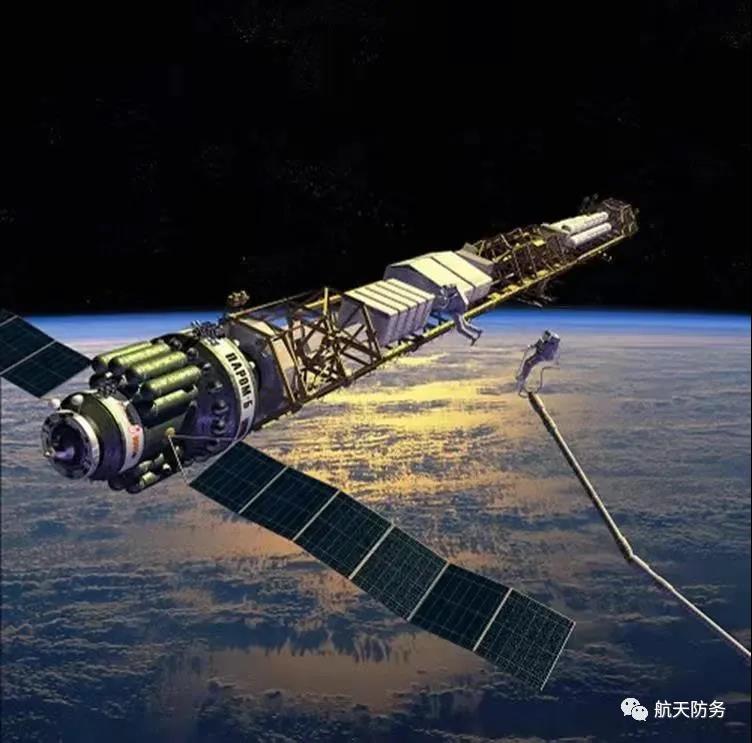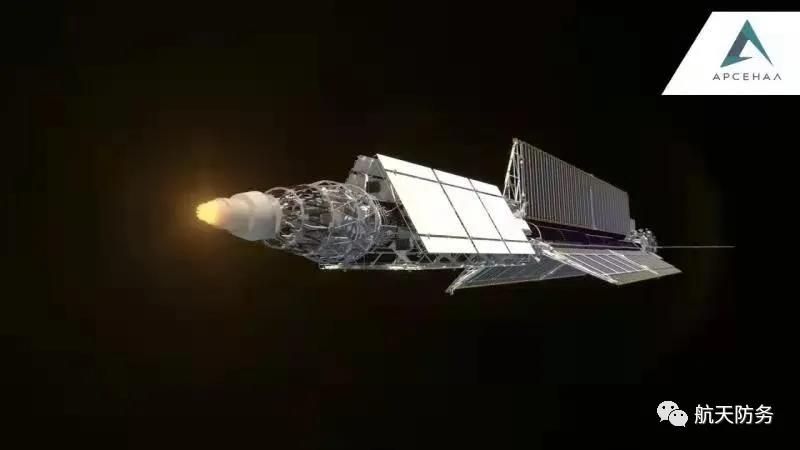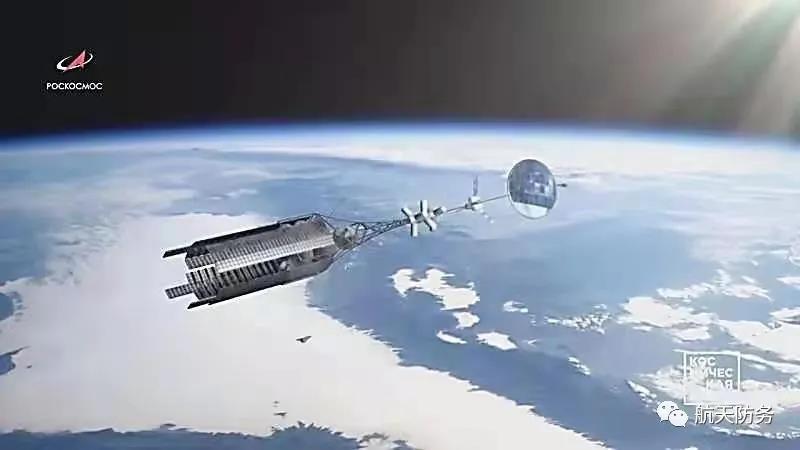The Eye of Space: Russia's "Zeus" nuclear powered space tugboat
On October 25, 2021, at the 72nd International Astronautical Congress in Dubai, United Arab Emirates, the Russian National Space Corporation showcased its "Zeus" nuclear powered space tugboat for the first time overseas. This space tugboat aims to enhance the spacecraft's orbit maneuvering and space navigation capabilities, and will become the main connecting vehicle between space stations in the future. It can also be applied to deep space exploration, performing complex military and scientific missions to Jupiter and other deep spaces. Russia plans to conduct the "Zeus" national flight test in 2030 and deploy it to an orbit at an altitude of 800 kilometers.
With the continuous development of human utilization of space, the development of propulsion devices that can fly in space for a long time and have strong endurance has always been the unremitting pursuit of countries. Since the end of the Cold War, the development of Russian space technology has been relatively slow, and nuclear powered space tugboats will be the only real opportunity for Russia to achieve its space renaissance strategy. (1) In the early 1960s, the first group of scientists in the Soviet space nuclear program, including Keldysh, Korolev, and Academician Kurchatov, proposed the idea of combining nuclear reactors with rocket electric engines. Since the 1970s, Korolev Energy Rocket Space Group has been committed to the research and development of nuclear power units for manufacturing space tugboats between orbits; From 1970 to 1988, the Soviet Union sent 32 thermoelectric nuclear powered spacecraft into different orbits; In the late 1990s, the Keldysh R&D Center of the Russian Aerospace Corporation restarted the space nuclear reactor transport power module program with the participation of the Moscow "Ray" Scientific Production Joint Company. In 2012, the entire space tugboat system modeling and technical design were completed on a supercomputer; In October 2018, the Keldysh R&D Center conducted ground tests on the cooling system of nuclear power engine units; In 2019, the Russian Aerospace Group tested transportation power module components and showcased the "Space Tug" model for the first time at the Moscow International Air and Space Exhibition. On September 3, 2020, the Russian Arsenal Design Bureau began assembling nuclear powered tugboats; At the "Military-2020" forum, Russia released a three-dimensional map of its space work; As an important part of the space tugboat project, a technology system will be built and put into use at the Dongfang Space Launch Site by 2030. In the past 10 years, the "Zeus" nuclear powered space tugboat has been a priority research and development project in Russia's space program.

(2) The system composition and technical performance of the "Zeus" space tugboat is currently a unique space project in the world, essentially a "nuclear power plant" that provides energy supply for payloads. The main feature of nuclear space tugboats is modular design and the ability to self load and supply power. Structurally speaking, "Zeus" is a transportation power module with an open architecture. The nuclear powered space tugboat consists of eight main systems, including a high-temperature nuclear reactor, an electric jet engine, a generator set, an instrument equipment compartment, a drip cooler truss, a backup solar cell, a drip cooler, a drip radiator generator, a telescopic truss, and a radiation protection device. These systems include a nuclear reactor system, an energy conversion system, an electric energy conversion system, a plasma electric rocket propulsion system, a heat dissipation system, an automatic control system, a radiation protection system, and a tugboat platform system. The maximum design lifespan of the transportation energy module is 10-12 years.
Table 1 Main Technical Performance of "Zeus"
Zeus space tugboat | |
Weight/kg | twenty thousand two hundred and ninety |
Working state, external dimensions/M | 53.4×21.6×21.6 |
Power unit current power/MW | 1 |
Electric rocket propulsion device speed/km/c | Not less than 70 |
Electric rocket propulsion system power/MW | Not greater than 0.94 |
Cruise electric rocket propulsion system total thrust/N | Not less than 18 |
Lifespan/year | 10-12 |
Transportation tools | Angara-A5 |
(3) The working principle of the Zeus nuclear powered tugboat is that the electric propulsion system heats and accelerates ionized gas, forming a jet that generates thrust to generate thrust. Therefore, it is also known as an ion or plasma engine, which has extremely high fuel efficiency and unique specific impulse, simplifying flight to the moon or Mars. The nuclear reactor is located at the bow of the spacecraft, heated to a temperature of 1600 degrees Celsius and generating heat through the ID-500 ion propulsion engine and maneuvering engine with a reactor capacity of 32-35 kilowatts. The circulating Brighton turbine is used to start the generator, converting mechanical energy into electrical energy.

Electricity generates plasma in four high-power ion thrusters with a diameter of 450 millimeters, causing the entire structure to accelerate slowly and for a long time, achieving long-term autonomous energy generation from megawatt level nuclear reactors and the ability to transport various payloads. The reactor will be cooled and heat dissipated through a drip cooler radiator system.
The important drawbacks of spacecraft using chemical energy are short endurance, limited fuel and payload capacity. Compared to other spacecraft, those using nuclear powered energy modules can achieve higher energy density and longer endurance. They are widely used in space transportation and deep space exploration, and have enormous potential in the military field. (1) The power of the nuclear reactor module of the space transport "Zeus" space tugboat will be increased to 500 kilowatts, which can not only meet the operation of the space tugboat between Earth orbit and the space station, but also assist in the construction of the lunar base and have the potential to carry out deep space exploration missions. The "Zeus" nuclear powered tugboat can achieve tasks such as deploying lunar modules, transporting goods in orbit, and deploying energy for space nuclear power plants. (2) The core technology of the "Zeus" space tugboat for deep space exploration lies in its propulsion system, which is essentially a space "nuclear power plant". The thrust generated by carrier rockets using chemical thrusters is insufficient to support deep space development. Due to the "Zeus" megawatt nuclear power plant, the space tugboat can carry 10 tons of payload from low Earth orbit to near Earth orbit within 200 days and can be used as an orbital station or landing module power source. Zeus not only provides power for spacecraft propulsion systems, but also for deep space exploration of the Moon, Mars, Venus, and asteroid belts.

(3) The military application of the "Zeus" nuclear space tugboat can be in orbit for a long time and has the capability of continuous space-based monitoring. It can provide continuous power for the monitoring radar and anti satellite laser of large spacecraft, effectively solving the problems of early warning detection and providing reliable target indication for missile weapons. According to the power of the radar, "Zeus" can obtain operational data of all aerospace flight targets from aircraft to intercontinental ballistic missiles at an altitude of 2200~4300 kilometers, becoming a component of the aerospace defense cascade air defense system. Laser and electromagnetic weapons can also be deployed on the space tugboat platform, and it can also serve as a comprehensive space combat command and control platform, with great potential in space combat.
The "Zeus" nuclear powered tugboat is currently a priority space project for Russia's development, with unique innovation in technology. Before flight testing, a large number of scientific, technological, and process problems still need to be solved. The development of the "Zeus" plan will undoubtedly promote the construction plan of the China Russia lunar base signed in March 2020 and further human exploration of space.